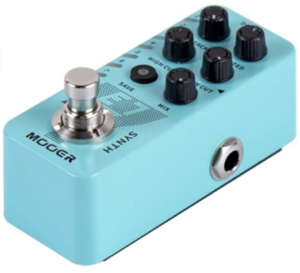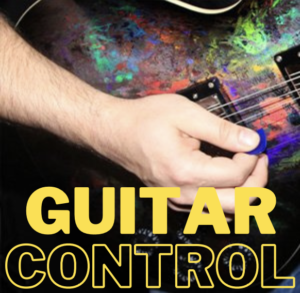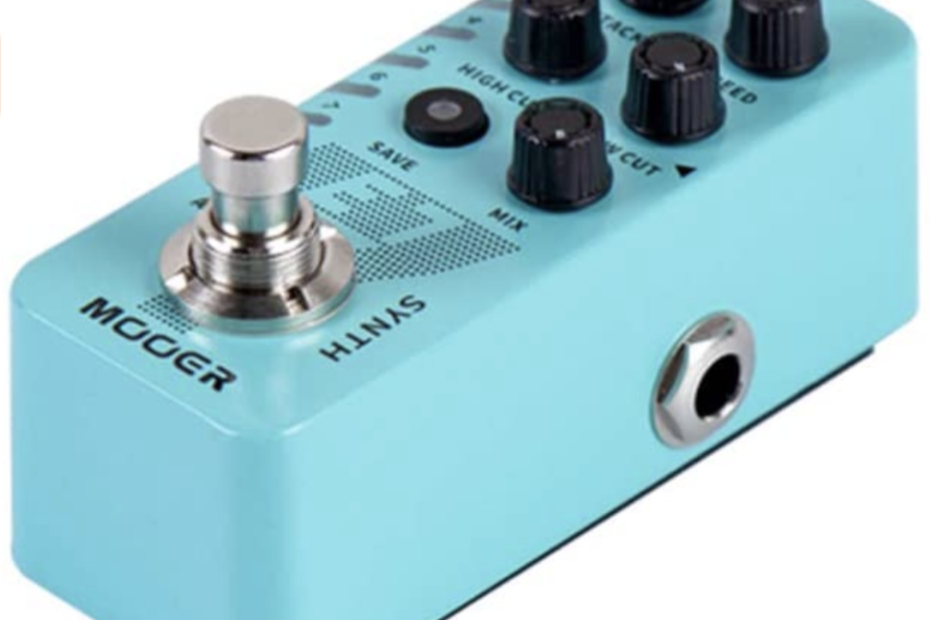 Mooer E7 is a pocket guitar synth pedal. It is very versatile, and has several synth tones that you can use to practice or to gig.
Mooer E7 is a pocket guitar synth pedal. It is very versatile, and has several synth tones that you can use to practice or to gig.
In this article I review the features and capability of this little pedal that has so much to offer.
What is a Synth Pedal?
A synth pedal is designed to make the guitar sound as a synthesizer. As such, you can have an almost infinite combination of sounds generated by this type of pedal. Other pedals in this category are Source Audio C4 and Boss SY-1.
The first synthesizers were designed for keyboards. The heyday of this type of instruments was in the 80s, but since them we still have a lot of music that uses synthesizers in one way or another.
For guitar players, the synth pedal is a method to have the same capability. Another method is using a MIDI guitar, which you can learn about in another article.
The quality of synth pedals has improved considerably in the last few years. This happened because the circuits that were only available in a powerful keyboard can now be miniaturized into a tiny guitar pedal.
Also Read:
MOOER Acoustikar Acoustic Guitar Simulator Pedal
Essential Guitar Pedals You Need to Have
6 Best Vocal Effects Pedals for 2022
Key 9 Pedal Review: Electric Piano Machine
Guitar Tricks Review And A Free Gift
Spark Amp: You’ll be Surprised By This Guitar Amp
What Is the E7 Polyphonic Guitar Synth
The Mooer E7 Polyphonic Guitar Synth is a compact pedal that allows guitarists to produce a wide range of synth sounds. It has seven different types of synthesizer sounds, including two string synth sounds, two bass synth sounds, and three lead synth sounds. The pedal uses polyphonic tracking technology, which means that it can detect and process multiple notes at once, allowing guitarists to play chords and complex melodies with ease.
The E7 has a simple interface with just three knobs and a toggle switch, making it easy to use and adjust on the fly. The first knob selects one of the seven synth sounds, while the second knob adjusts the attack and sustain of the sound. The third knob controls the overall mix between the guitar and the synth sound.
The E7 can be used with a standard guitar input, or with an optional expression pedal, which allows for real-time control of the synth sound. It also has a built-in sequencer, which can be used to create and save up to 9 different custom synth sounds.
Functionality of the E7 Polyphonic Synth
 The E7 Polyphonic Synth can transform your guitar into a typical electronic synthesizer, without the need for special pickups or instrument modifications.
The E7 Polyphonic Synth can transform your guitar into a typical electronic synthesizer, without the need for special pickups or instrument modifications.
The pedal is named as E7, for its seven available custom synthesized tones. The E7 not only provides traditional synthesized sounds, but is also an arpeggiator. This means that it can produce arpeggios in different effects and configurations.
The Mooer E7 Polyphonic Guitar Synth is a compact and affordable pedal with a variety of features. Some of the main features include:
- Polyphonic tracking: The E7 tracks multiple notes at once, allowing you to play chords and complex arrangements.
- Wide range of synth sounds: The pedal includes 7 different synth sounds, including lead, bass, organ, bell, and more.
- Easy to use: The simple interface makes it easy to select and dial in your desired sound, with controls for level, tone, and decay.
- Versatile connectivity: The E7 features both mono and stereo outputs, as well as MIDI input, allowing you to integrate it with a wide range of other gear.
- Compact and portable: The pedal is small enough to fit on any pedalboard, making it a great option for guitarists who want to add synth sounds to their live or studio setups.
Check Low Price for E7 on Amazon!
Polyphonic Guitar: Mooer E7 Synth Advantages
The E7 Polyphonic Guitar Synth utilizes advanced digital signal processing algorithms to analyze the incoming guitar signal and convert it into polyphonic synth tones. It can create a variety of synth sounds including leads, pads, basses, and atmospheric textures. The pedal is equipped with various parameters and controls that allow for extensive sound shaping and customization.
Here are some key advantages of the Mooer E7 Polyphonic Guitar Synth:
- Polyphonic Synthesis: The pedal enables polyphonic tracking, which means it can detect and reproduce multiple notes simultaneously, allowing for chordal playing and complex harmonies.
- Wide Range of Synth Tones: The E7 offers a diverse palette of synth sounds, from classic analog-style tones to modern digital textures. It includes presets that emulate iconic synthesizers, as well as original synth sounds.
- Intuitive Controls: The pedal features knobs and switches that allow for real-time adjustment of various parameters such as waveform, filter cutoff, resonance, envelope, and modulation. This gives you control over the sound shaping and allows you to customize the synth tones to your liking.
- Built-In Effects: The E7 includes built-in effects such as reverb and delay, which can further enhance and shape the synth sounds.
- Presets and Memory Storage: The pedal offers preset slots where you can store and recall your favorite synth sounds. This allows for quick access to different tones during live performances or recording sessions.
- Expression Pedal Input: The E7 has an expression pedal input, enabling you to control parameters like filter cutoff or modulation depth in real-time for dynamic and expressive playing.
- True Bypass: The pedal features true bypass switching, ensuring that your guitar’s original tone remains unaffected when the effect is turned off.
Main Features of the Mooer E7 Synth
The Mower E7 pedal provides brand-new MOOER synth tones. Moreover, these features are straightforward to use by any guitar player, through the use of 7 LED indicators on the right side of the case.
The 7 different MOOER custom synthesizer tones can be adjusted to any synth tones using adjustment knobs, just the way you enjoy. The synths types include the following:
- Trumpet,
- Organ,
- Sea wave,
- Weeyo,
- Saw wave,
- 8bits,
- EDM,
- Pad.
The Mooer E7 Polyphonic Guitar Synth provides a wide range of synth tones, including:
- Poly 1: A fat and warm polyphonic synth tone with an octave-down effect.
- Poly 2: A shimmering synth sound with a fast attack and slow release.
- Bass 1: A deep and rich bass synth tone that is ideal for funk or dance music.
- Bass 2: A more aggressive and edgy bass synth tone with a mid-range boost.
- Lead 1: A powerful lead synth tone with a strong sustain and a touch of delay.
- Lead 2: A smooth and silky lead synth tone with a hint of chorus.
- ARP 1: An arpeggio-style synth tone with a bright and cheerful sound.
- ARP 2: A more complex arpeggio-style synth tone with a wide stereo spread.
- Pad 1: A lush and dreamy pad synth tone with a slow attack and long release.
- Pad 2: A warm and soothing pad synth tone with a gentle attack and soft release.
 There are also 7 slots for storing users’ presets. You can take advantage of these presets to transform your guitar into a typical electronic synthesizer. All this without the need for special pickups or instrument modifications.
There are also 7 slots for storing users’ presets. You can take advantage of these presets to transform your guitar into a typical electronic synthesizer. All this without the need for special pickups or instrument modifications.
Each tone in this library also comes with an individual arpeggiator. The are also parameters that can be set, including the following:
- high/low frequency cut,
- sound attack,
- speed function.
The combination of parameters and tones will allow users to shape the tone easily. Using this system, you can get any sound you can imagine, exploring the big horizon of tones possible with the E7.
It is important to emphasize that the Moor E7 can transform your guitar into a full electronic synthesizer. There’s no need for special MIDI pickups or other instrument modifications.
How to use the Mooer E7 Synth guitar pedal
 To use the Mooer E7 guitar pedal, follow these steps:
To use the Mooer E7 guitar pedal, follow these steps:
- Connect your guitar: Plug your guitar into the input jack of the pedal using a standard instrument cable.
- Connect your amplifier or audio interface: Use another instrument cable to connect the output jack of the pedal to the input of your amplifier or audio interface.
- Power on the pedal: Use a suitable power supply or battery to power on the Mooer E7 pedal. Make sure the power source meets the required voltage specifications of the pedal.
- Set the controls: The Mooer E7 pedal features various controls that allow you to shape your guitar’s sound. These controls typically include knobs for adjusting the level, tone, and effect parameters. Experiment with these controls to find your desired sound.
- Select the desired effect: The Mooer E7 offers multiple built-in effects, such as delay, reverb, modulation, and more. Use the mode selector or footswitches to choose the effect you want to use.
- Adjust the settings: Once you’ve selected the desired effect, use the corresponding controls to adjust the specific parameters of that effect. For example, if you’ve chosen the delay effect, you can adjust parameters like delay time, feedback, and mix.
- Activate the effect: Use the footswitches or buttons on the Mooer E7 pedal to activate or bypass the effect. This allows you to switch between your clean guitar signal and the processed signal with the effect engaged.
- Experiment and fine-tune: Spend some time exploring different combinations of effects, tweaking the settings, and listening to how they enhance your guitar’s sound. The Mooer E7 offers a range of options to help you create unique and personalized tones.
- Practice and perform: Once you’ve dialed in your desired sound, use the Mooer E7 pedal during your practice sessions or performances to add depth, texture, and character to your guitar playing.
Technical Specs

Here are the full technical specs for this pedal:
- Input:1/4 Mono Jack input, can be connected to any guitar or similar instrument.
- Output:1/4 Mono Jack output, can be directed to an Amp or oaffiliate linkther pedal combination.
- Power Supply: 9V DC.
- Current Draw: 200mA.
- Polyphonic synthesizer pedal for guitar or bas
- 7 different synth tones including: lead, poly, bass, organ, string, brass, and flute
- User-friendly 3-knob interface with preset, tone, and volume controls
- True bypass switching
- Input impedance: 2.2M Ohms
- Output impedance: 100 Ohms
- Power supply: DC 9V, 160mA (not included)
- Dimensions: 93.5mm (D) x 42mm (W) x 52mm (H)
- Weight: 146g
Moor E7 Manual
You can find the Moor E7 Manual in its web page. There you will find additional information such as:
- Features
- Connection
- Technical Specifications
- Demo Options
- Moor E7 Firmware update options, and how to perform the firmware update for new versions of the Moor E7 software.
Other Options: Synth Pedals in the Market
There are several similar products to the Mooer E7 Polyphonic Guitar Synth that offer similar features and capabilities. Some examples include:
- Boss SY-1 Synthesizer – The Boss SY-1 is a highly regarded guitar synthesizer pedal known for its advanced technology and wide range of synth sounds. It offers polyphonic tracking, customizable parameters, and extensive control options, making it a versatile and powerful choice for guitarists seeking synth capabilities..
- Electro-Harmonix Superego+ Synth Engine – The Superego+ by Electro-Harmonix is a synthesizer and multi-effect pedal that combines synth sounds, sustain, and sample playback. It offers rich textures, layering capabilities, and built-in effects, allowing guitarists to create unique soundscapes and ambient tones..
- Source Audio C4 Synth – The Source Audio C4 Synth is a compact and feature-packed guitar synthesizer pedal. It provides a wide range of synth sounds, adjustable parameters, and deep editing capabilities. It also includes an extensive library of preset sounds and the ability to save and recall custom presets. It is a compact pedal with a variety of synth sounds and parameters, as well as customizable presets and MIDI capability.
- Roland GR-55 Guitar Synthesizer – a more advanced guitar synth system that includes a guitar pickup and processing unit, as well as a variety of synth sounds and effects. The Roland GR-55 is a popular guitar synthesizer that combines synth tones, modeling technology, and built-in effects. It offers an extensive sound library, realistic tracking, and the ability to blend guitar and synth sounds seamlessly. It also includes features like MIDI connectivity and backing tracks for live performances.
- Korg Miku Stomp: While unique in its functionality, the Korg Miku Stomp is a vocal synthesizer pedal designed to replicate the sound of a Japanese vocaloid character. It provides quirky and expressive vocal-like sounds that can add an interesting element to guitar playing.
- Pigtronix Mothership 2 Analog Synthesizer – a unique synth pedal that uses a combination of analog and digital processing to create a wide range of sounds, with multiple oscillators, filters and LFOs.
 Synthesizer Machine Pedal: the Electro-Harmonix Synth 9 is another pedal that offer many of the features present in the Moor E7.
Synthesizer Machine Pedal: the Electro-Harmonix Synth 9 is another pedal that offer many of the features present in the Moor E7.
If contains several different synth sounds that can be combined in different ways, using the set of knobs provided.
